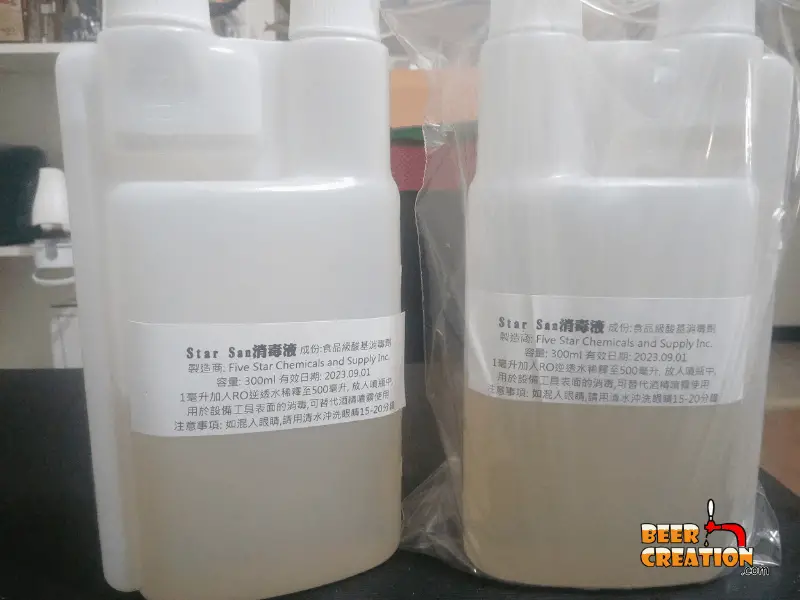Out of all the factors that go into making a good homebrew, sanitation is the most important—infection will ruin a batch of otherwise well-made beer.
The most famous no-rinse sanitizer on the market for brewers is Star San. It isn’t notably expensive, but with all the sanitizing a brewer has to do—especially if they’re brewing often—the cost (and the labor) can start to add up.
The most common question regarding Star San is whether or not it can be reused once we’ve diluted it.
Diluted Star San can be reused multiple times providing it has a pH of 3.5 or less. Contrary to popular belief, clearness of the fluid is not necessarily a dependable indicator of usability. To gauge Star San’s pH, pH test strips can be used. At a pH over 3.5, the Star San should be discarded.
Well that’s the scientific answer, but there’s more to know about using/reusing Star San, and I also want to touch on a point that confuses a lot of people new to homebrewing—the difference between cleaning and sanitizing your equipment—because Star San sanitizes.
It doesn’t clean.
Keep reading, because I’ve got the answer to these questions and others!
How many times can you reuse Star San?

You can reuse Star San (link to Amazon) as many times as you want as long as you do a pH strip test and get a reading of 3.5 or less.
What is Star San’s shelf life?
If you’ve got a bottle of concentrated/undiluted Star San, Five Star Chemicals themselves recommend tossing it if it’s older than two years.
If you’ve diluted it, there is no black-and-white shelf life. The fluid is still good and reusable until its pH is over 3.5. At a pH over 3.5? Toss it.
For those of you who want a ballpark estimate, I know some folks who’ve kept 5 gallons of soft-water-diluted Star San in an airtight plastic jug for 6 months, and the pH has stayed below 3.5 just fine.
So that tells you there are some steps you can take to keep the pH low when you’re storing your sanitizer: use distilled or RO water instead of tap, and make sure the lid is closed tight.
For more information on this, check out my more in-depth article here.

New to homebrewing? Please feel free to read my ultimate guide to brewing beer at home and where to start.
How do you test the pH of your Star San?
You’ve got two options when it comes to figuring out if your Star San is good to reuse or not.
You can either use a pH test meter (link to Amazon) or you can go with pH indicator strips, such as these by Hydrion (link to Amazon).
Both have their pros and cons. Meters are simple to read but require more maintenance. Indicator strips are not hard to read but you have to look a bit closer at them than you do for meters.
To use strips, take one out, immerse it in your test sample of Star San, remove it immediately, and then—if you’re using the Hydrion strips – match the color that appears on the strip to the color on the indicator chart.
If it matches the 3.5 color, that’s good. If it’s closer to oranges or reds (lower than 3.5) that’s even better.
If it’s looking greener than the yellow-green of the 3.5, that’s bad. The pH is too high, and the sanitizer won’t be effective.
See what I mean when I say you have to look closer at strips than you do at meters?
Again, though, that doesn’t mean strips are hard to use (unless you happen to be color blind, in which case it’d be tough, and you’d need a brew buddy to help you out)!
Can you reuse Star San even if it has ‘floaties’ in it?
So you know you can reuse your Star San, but what about if it has some floaties in it?
“Floaties” are the general term for bits of debris that get left over in your Star San solution after you’ve immersed your brewing equipment in it. Even if your Star San has floaties, as long as its pH is under 3.5, it’s fine to use again.
The acid of the sanitizer is going to kill anything alive on those floaties, so you’re okay.
Still, and I’ve said it before, if my solution has a ton of stuff floating in it, I’d dump it out and make more. Just a personal preference, but I know a lot of other brewers are of the same mind.
Better yet, why not use a spray bottle for sanitizing? You don’t have to submerge everything in Star San to get it sanitized.
When’s your next brew day?
Get your brewing supplies directing from
https://www.homebrewing.org/
Is cloudy Star San ineffective?
The cloudy appearance of Star San isn’t a definitive indicator of its effectiveness, and only a pH test will confirm this. There are many factors which will lead to a cloudy Star San Solution, none of which automatically render it ineffective.
Previously, homebrew wisdom had it that clarity and pH under 3.5 were the markers of effective Star San.
However, representatives from Five Star Chemicals themselves have stated in essence that clarity—or lack thereof—doesn’t in itself tell you whether a batch of Star San is good to go.
And Star San that looks a bit cloudy doesn’t necessarily mean the sanitizer shouldn’t be used.
In other words, Star San that’s no longer effective will look cloudy, but cloudy Star San could be ineffective OR effective.
Honestly, all cloudy Star San means is that the surfactants in it have come out of the solution due to reaction with the water’s metals.
If you’re diluting your Star San with city water and it turns cloudy as soon as you make it, you’ve probably got hard water, so the surfactants in your sanitizer are reacting to the high level of metals right away.
That doesn’t mean the Star San is ineffective. If you do a pH strip test and get a reading under 3.5, you’ve got yourself some good yet cloudy Star San.
How can I stop Star San from getting cloudy immediately?
I get it. It looks weird using less than pristine sanitizer even if your test strips tell you its pH is within effective levels.
A lot of homebrewers feel most confident using clear Star San that has an acceptable pH, and there’s nothing wrong with that.
It’s an easy fix, although it will cost you a little more than just using your home sink: use distilled water or Reverse Osmosis (RO) water instead of tap—that will do the trick.
Many supermarkets have distilled or RO water for sale at the front of the store. You can just bring your own bottles and fill up from the spout.
Alternatively, you may want to look into getting a Reverse Osmosis system for your home. That’ll run you more than filling jugs as needed at the supermarket, but plenty of people find the cost totally work it.
Here’s an RO unit from Amazon you may want to check out.
What’s the difference between cleaning and sanitizing in homebrewing?
Cleaning and sanitizing all homebrewing equipment used to make beer is essential. During the brewing process, organic matter will build up in items such as brew kettles & fermenters. These need to be fully cleaned. Despite cleaning, bacteria will still be present & must be removed during sanitizing.
Cleaning comes first. It means getting the dirt and residue off any and all equipment that’s going to touch your beer or beer ingredients—including bottles which most new brewers forget about.
What is this “dirt?”
In beer brewing, “dirt” is a general term that usually means a buildup of proteins and minerals from water, grain, hops, and fruit.
Bacteria will start to grow in these leftover bits, leaving you with a grime that sticks to plastic (and glass) very easily.
By cleaning, you get rid of the dirt and buildup, but living organisms can still remain— usually mold, wild yeasts, and bacteria that can infect and ruin your beer.
Sanitizing, the crucial second step, gets rid of those living organisms. There are many different ways to sanitize your equipment and remove this troublesome bacteria.
Star San is ideal as, when diluted correctly, it is a no-rinse solution which can really speed up your brewing day. (For other ideas to speed it up, please check out my other article here)
How to clean homebrewing equipment
✔️ Fill up your bucket or fermenter with warm water and then the prescribed amount of a cleaner like Powdered Brewery Wash (PBW) or One Step (links to Amazon).
✔️ Scrub everything very, very well. (Don’t use abrasive brushes or pads on your plastic buckets or carboys. They can cause scratches that bacteria can hide in. Do use a soft sponge or cloth.)
✔️ Soak everything for at least 20 minutes. Often leaving it overnight and cleaning up the next day makes brewing easier in my humble opinion.
How to sanitize your homebrewing equipment
If you’re using Star San, follow the instructions on the bottle to prepare the sanitizer.
✔️ use 1 fluid ounce of Star San for every 5 gallons of water.
✔️ Immerse your equipment in the diluted sanitizer for at least 30 seconds, or you can use a spray bottle, which is just as effective.
✔️ If diluted to the correct ph level (3.5), Star San doesn’t require rinsing off.
If you happen to have run out of Star San but you need to sanitize ASAP, there are other sanitizing options that I go into here in this article.
How much Star San should you make at a time?
The most efficient way to use Star San, as I see it, is to keep a spray bottle of it around and have 1-5 gallons of extra diluted sanitizer handy for refilling.
You’ll use the spray bottle for your smaller brewing equipment, mash paddles, scissors to open the yeast etc. But you will still want to dump in a gallon or so into a fermenter or keg to give it a through but quick sanitizing.
Recommended gear
Here are some essential items if you are just getting into homebrewing and want to make really good beer.
Please note that the links below will take you to Amazon and any purchases will result in a commission for me which doesn’t in any way impact your purchase.
Cleaning products
One Step Cleaner

See the latest prices on Amazon
Star San

Check out the latest prices and availability on Amazon.
Star San & PBW Cleaner Combo

See the latest prices here on Amazon
Further reading
You may also be interested in this article:






